NC Coast: Sand, Ships & Sun
Posted on June 1, 2016 by bob in ThingsToDo, Travel
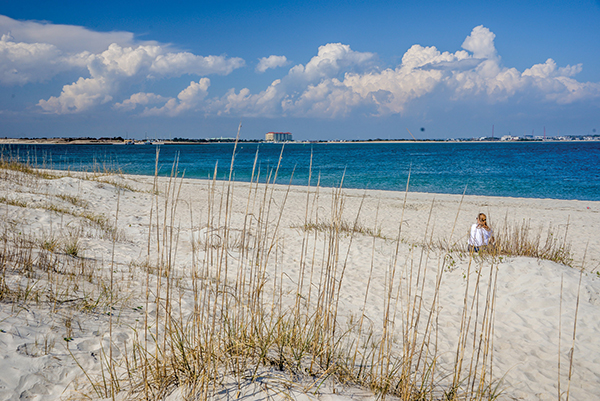
The North Carolina coast encourages folks to enjoy the sun as well as the historic sites.
by Andrea Gross; photos by Irv Green
A few days before my husband and I leave for a beach vacation on the North Carolina coast, I happen across a news article:
“Researchers are calling an iron-hulled Civil War era steamer found near Caswell Beach one of the best-preserved blockade runners they’ve ever seen….” — Adam Wagner, Star News, March 7, 2016
It’s been decades since one of these ships was discovered, so this is a very big deal. And while we wouldn’t be able to see the wreck—it’s still buried under 18-20 feet of ocean—as we read more we realized how important the sea was to the growth of America.
The United States was settled by seafaring people during the sixteenth century, blockaded and bombarded from the sea during the nineteenth and many of its cities became major ports during the twentieth. We have a lot to explore between beach outings.
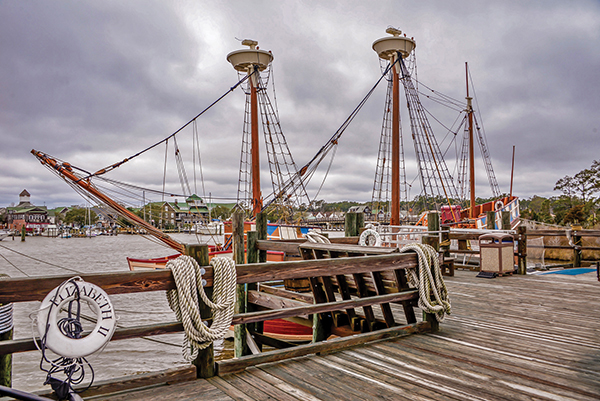
In the 16th century vessels like Elizabeth II sailed the Atlantic to lay claim to the New World.
We time-travel back more than 400 years by going to the Outer Banks near the North Carolina-Virginia state line. Here, not far from the Bodie Island Lighthouse, is Roanoke Island Festival Park, featuring a full-size replica of a British merchant vessel. In 1585 seven of these vessels sailed to the New World in order to claim territory for England. The waters were so hazardous that the area is often called “The Graveyard of the Atlantic.”
“A big part of navigating is going the direction the wind wants you to go,” says a sailor, authentically outfitted in sixteenth-century garb.
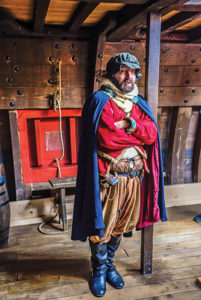
A costumed interpreter explains what life was like aboard early merchant vessels.
A man standing next to me grins. “Seems that the history of America was written by the wind,” he says. Point well taken.
Near the ship is a small Algonquian town, replete with longhouse and dugout canoe, that shows what the mariners found when they followed the wind across the ocean. A few steps further and we see a representative English village, where a blacksmith and woodworker explain how the first settlers lived.
Life on coastal Carolina had improved considerably by the eighteenth century, as evidenced in Beaufort, 175 miles south. Today costumed docents give tours of nine historic buildings and discuss daily life during the Colonial period. Of course, living on water’s edge is both a blessing and a curse. Beautiful? Absolutely. Dangerous? Definitely.
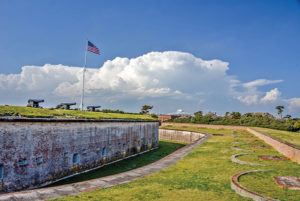
Fort Macon is one of several forts built along the Eastern Seaboard to protect the country from attacks by sea.
Having learned during the War of 1812 that their young country was vulnerable to attacks by sea, the United States government rushed to build forts along the Eastern seaboard. But for North Carolina, the enemy came not from across the Atlantic but from across the Potomac. When the Civil War broke out, the Confederates quickly occupied Fort Macon, which is surrounded on three sides by water. They held the fort for nearly a year, until April 1862 when they were forced to surrender.
We fast-forward through a century and a-half during the two-hour drive to Wilmington, the largest city along the coast. While Wilmington has a 230-block historic district filled with buildings that are both imposing and funky, it also has a vibrant downtown filled with thoroughly modern attractions. There’s top-notch theater (much of it produced in a 150-year-old building), cutting-edge restaurants and an eclectic assortment of shops that among other things offer bookshelves laden with two miles of books and cupcakes infused with cherry compote.
After ensconcing ourselves in the historic French House B&B, we take a Walk & Talk Tour that covers topics ranging from the town’s early days and the importance of the city’s waterfront location, to the role of North Carolina during World War II.
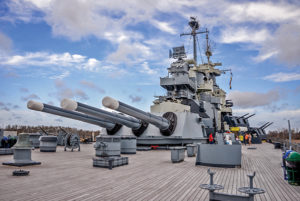 Now parked in the river near downtown Wilmington, The USS North Carolina was one of the fastest and most highly decorated battleships in the American fleet. It takes us nearly a half day to see the exhibits, explore the decks, and listen to the recorded stories of the men who lived in the cramped quarters, worked in the engine room and fired the giant guns.
Now parked in the river near downtown Wilmington, The USS North Carolina was one of the fastest and most highly decorated battleships in the American fleet. It takes us nearly a half day to see the exhibits, explore the decks, and listen to the recorded stories of the men who lived in the cramped quarters, worked in the engine room and fired the giant guns.
We’re still in a sober frame of mind as we head toward Southport, a charming community not too far from the North Carolina-South Carolina state line. During the 1500s when the British were settling Carolina’s northern shore, the Spanish were exploring the future state’s southern coast. Today the area is equally well known as the filming location for the Nicholas Sparks’ movie Safe Haven. How times have changed!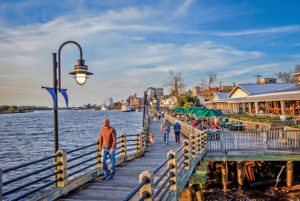
Finally we get to Caswell Beach. Off to the left is Old Baldy, the oldest existing lighthouse in North Carolina. Right behind us is the Oak Island lighthouse, the newest and most southern lighthouse in the state. And in front of us, in the Atlantic Ocean, is the spot where the historic blockade runner was discovered.
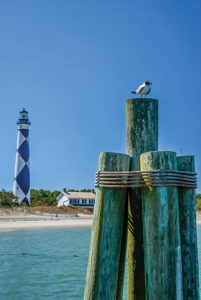 We’ve traveled nearly 400 miles, learned about more than 400 years, and slathered ourselves with more than four tubes of sunscreen. It’s been a varied, stimulating and yet relaxing trip. By our standards, that means it’s been a perfect vacation.
We’ve traveled nearly 400 miles, learned about more than 400 years, and slathered ourselves with more than four tubes of sunscreen. It’s been a varied, stimulating and yet relaxing trip. By our standards, that means it’s been a perfect vacation.
For an expanded version of this article, as well as information on how film lovers can “follow the stars” along the NC Coast, go to www.traveltizers.com.









